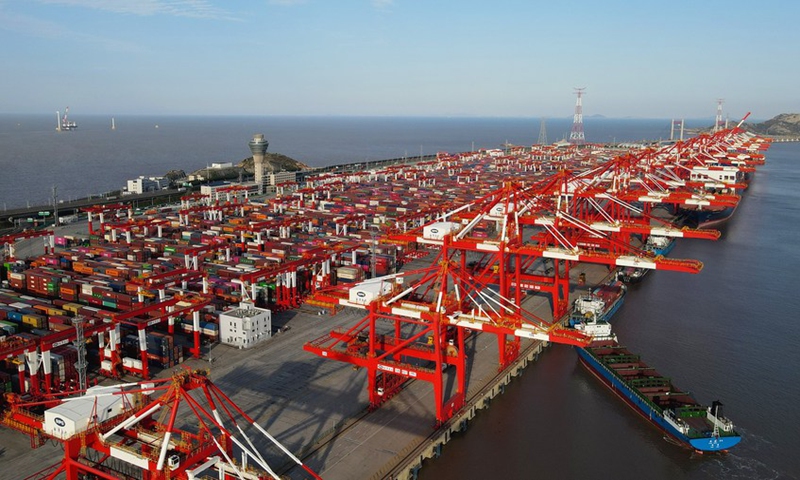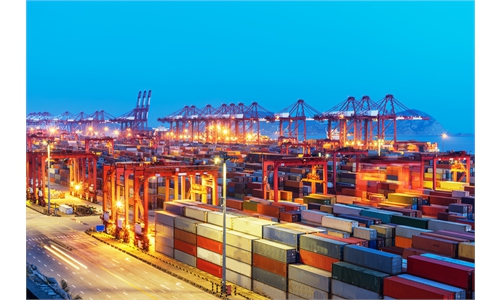Small goods owners shift business in Shanghai to neighboring ports as world’s largest port congested

Aerial photo taken on April 6, 2021 shows a view of the automated container terminal of Shanghai's Yangshan Port, east China.(Photo: Xinhua)
The Chinese government is taking more concrete measures to relieve the congestion at the Shanghai port, the world's largest port in terms of container turnover, part of the move to ensure smooth logistics amid disruptions posed by COVID-19 outbreaks and minimize the impact on economic activities.
Market players said that it is hard to see quick relief given that the congestion happens on the road instead of the port, and some carriers are shifting their goods to neighboring ports to shorten waiting time.
"Shore congestion at the Shanghai port is very serious and nearly 60 percent of the cargo at sea and air terminals are "unclaimed," and the number is rising," Zhong Zhechao, founder of One Shipping, an international logistics service consulting company, told the Global Times on Friday.
Zhong said the congestion is brought by unloaded containers, and arriving ships worsen the congestion.
Zhong's remarks come on the heels of the Joint Prevention and Control Mechanism of the State Council on Thursday, which asked different links on the logistics chain, from shipping companies and cargo owners to shipping agents and freight trucks, to work more closely to enhance the turnover of goods at the port.
The suggestions released by the State Council have a special item regarding the port, highlighting the importance of relieving the congestion at the Shanghai port.
Relevant parties should keep communications with shipping companies on the number of reefer containers inside the port and update power sockets for such containers carrying refrigerated cargo to ensure the stable and orderly handling of the containers.
In one week, different departments in China continuously released files to ensure the smooth movement of cargo through the logistics system, a quick response to regional actions that have caused growing disruptions to supply chains and trade.
Wu Minghua, a shipping expert based in Shanghai, said the repeated emphasis on containers stranded at the port underscored the dire situation, and the refrigerated containers and chemical cargo containers in cold-chain logistics have the most severe bottlenecks.
Shanghai International Port Group (SIPG) said that they are accelerating waterway business, and provide customers with efficient and convenient waterway transportation services.
The SIPG is the exclusive operator of all the public terminals in the Port of Shanghai which handled 47 million standard containers in 2021 and has been the world's top container port for 12 consecutive years.
Several market insiders told the Global Times that the congestion is not the main problem, and the main reason is the congestion in the freight expressway, which is still relatively serious.
Seventy percent of the goods at the Shanghai port are related to the Yangtze River Delta region, and 80-90 percent of the goods in the Yangtze River Delta region are transported to the port by land, Zhao Nan, a research fellow at the Shanghai International Shipping Research Center, told the Global Times on Friday.
A Shanghai-based logistics service provider surnamed Zhao said that "it takes six to eight hours for the truck to get off the expressway."
Data from shipping big data company Elane sent to the Global Times shows that the status of congestion in Shanghai port was "unblocked" on Thursday, and the average waiting hours for one ship was 22 hours, lower than the 28.5 hours on average in the past seven days.
The average waiting time was around one day before the virus.
The Shanghai port has no congestion, and the number of container ships has actually decreased, but the epidemic has hurt the expressway transport, Chen Yang, chief editor of Xinde Marine News, told the Global Times on Friday. "Every link should be smooth."
Because of the spillover effect of the Shanghai port, many goods are pulled to the Ningbo-Zhoushan Port, in neighboring Zhejiang Province which puts heavy pressure on it.
Zhao Nan from Shanghai International Shipping Research Center told the Global Times on Friday that some small cargo owners no longer go to the Shanghai port, but are diverted to the Ningbo-Zhoushan Port to save time.
Data from the Ningbo-Zhoushan Port shows that from April 1 to 3, the average daily container throughput exceeded 100,000 TEUs, exceeding the daily average of last year and the first quarter of this year, of which 131,000 TEUs were completed on April 2. It is the second highest single day this year.
Zhao suggested that waterways should play a greater role in solving the port congestion. In the past two years, the Shanghai port established an inland container terminal in Taicang, East China's Jiangsu Province which is believed to play an important role in relieving port congestion.



